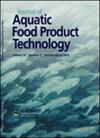Evaluation of Surface Properties of Chitosan and Scale Gelatin Coatings on Shrimp Fillets (Litopenaeus vannamei)
IF 1.3
4区 农林科学
Q4 FOOD SCIENCE & TECHNOLOGY
引用次数: 0
Abstract
ABSTRACT This study aimed to evaluate the wettability of edible coatings based on chitosan or the gelatin of Nile tilapia (Oreochromis niloticus) scales on the surface of shrimp fillets (Litopenaeus vannamei) with glycerol as a plasticizer. Initially, the surface was characterized according to Zisman’s methodology. The surface tension and dispersive and polar components of the shrimp fillet was 59.93 (low-energy surface), 14.14, and 45.79 mN/m, respectively. The mathematical modeling applied to experimental design 32 showed that the minimum concentration of biopolymers favored wettability, among other observations about the interactions between the components of the coatings and the surface of the shrimp fillet. The behavior of the plasticizer was influenced by the biopolymer; as the concentration of the plasticizer increased, the cohesion coefficient of chitosan coatings decreased, while the opposite effect was observed for gelatin coatings. The coating compositions with optimized wettability were 1.0% chitosan and 0% glycerol (W s = −12.934 mN/m), and 1.0% gelatin and 0% glycerol (W s = −5.588 mN/m).壳聚糖和鳞片明胶包膜对凡纳滨对虾鱼片表面性能的评价
摘要本研究以甘油三酯为增塑剂,研究壳聚糖和尼罗罗非鱼鱼鳞明胶在凡纳滨对虾片表面的润湿性。最初,根据Zisman的方法对表面进行表征。虾片的表面张力、色散和极性组分分别为59.93 mN/m(低能面)、14.14 mN/m和45.79 mN/m。应用于实验设计32的数学模型表明,最低浓度的生物聚合物有利于润湿性,以及其他关于涂层成分与虾片表面之间相互作用的观察结果。增塑剂的性能受生物聚合物的影响;随着增塑剂浓度的增加,壳聚糖涂层的内聚系数降低,而明胶涂层的内聚系数则相反。润湿性最佳的涂层组合为1.0%壳聚糖和0%甘油(W s = - 12.934 mN/m)和1.0%明胶和0%甘油(W s = - 5.588 mN/m)。
本文章由计算机程序翻译,如有差异,请以英文原文为准。
求助全文
约1分钟内获得全文
求助全文
来源期刊
CiteScore
3.50
自引率
6.20%
发文量
77
审稿时长
7 months
期刊介绍:
The Journal of Aquatic Food Product Technology publishes research papers, short communications, and review articles concerning the application of science and technology and biotechnology to all aspects of research, innovation, production, and distribution of food products originating from the marine and freshwater bodies of the world. The journal features articles on various aspects of basic and applied science in topics related to:
-harvesting and handling practices-
processing with traditional and new technologies-
refrigeration and freezing-
packaging and storage-
safety and traceability-
byproduct utilization-
consumer attitudes toward aquatic food.
The Journal also covers basic studies of aquatic products as related to food chemistry, microbiology, and engineering, such as all flora and fauna from aquatic environs, including seaweeds and underutilized species used directly for human consumption or alternative uses. Special features in the journal include guest editorials by specialists in their fields and book reviews covering a wide range of topics.

 求助内容:
求助内容: 应助结果提醒方式:
应助结果提醒方式:


